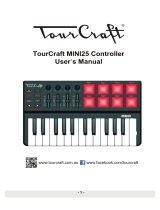
Table of Contents
Types of Parameters ................................ 3
How to Set Up Parameters ...................... 4
Performance screen and settings
screen ................................................. 4
How to use the performance screen 4
How to use the settings screen......... 5
Setting the controllers ...................................... 5
Setting other scene parameters ....................... 5
Setting global parameters ................................5
Saving the settings ............................ 6
Details of Parameters .............................. 7
Performance parameters .................. 7
Parameters common in all modes.................... 7
Parameters related to a scale and a key ......... 7
Parameter related to the touch scale ............... 7
Parameter related to the chord scale ............... 7
Parameters related to the arpeggiator ............. 8
Parameters related to the sliders, knobs, F1–F8
buttons and transport buttons .......................... 9
Parameters related to the Track pad mode .... 10
Scene parameters ............................ 10
Parameters related to the entire scene .......... 10
Parameters related to controllers ................... 10
Parameter List ................................................ 12
Global parameters ........................... 14
Velocity ........................................................... 14
MIDI setup ...................................................... 15
Trackpad ........................................................ 16
Touch Pad ......................................................16
Value Slider .................................................... 16
Display ........................................................... 16
TRITON taktile Sound Source Param-
eters .................................................. 17
Program Parameter Types ............................. 17
Appendix ................................................ 18
Troubleshooting .............................. 18
The power will not turn on. ............................. 18
There is no response from the software. ...... 18
Sometimes it is not recognized as a USB de-
vice. ................................................................ 18
Buttons do not function as indicated on the tak-
tile/TRITON taktile. ......................................... 18
The velocity of the keyboard or the trigger pad
has no effect. .................................................. 18
The arpeggiator will not function. ................... 18
No MIDI messages are transmitted from the
MIDI OUT connector. ..................................... 19
No sound ........................................................ 19
Useful functions .............................. 19
Restoring the factory settings ........ 19
Scale List .......................................... 20























